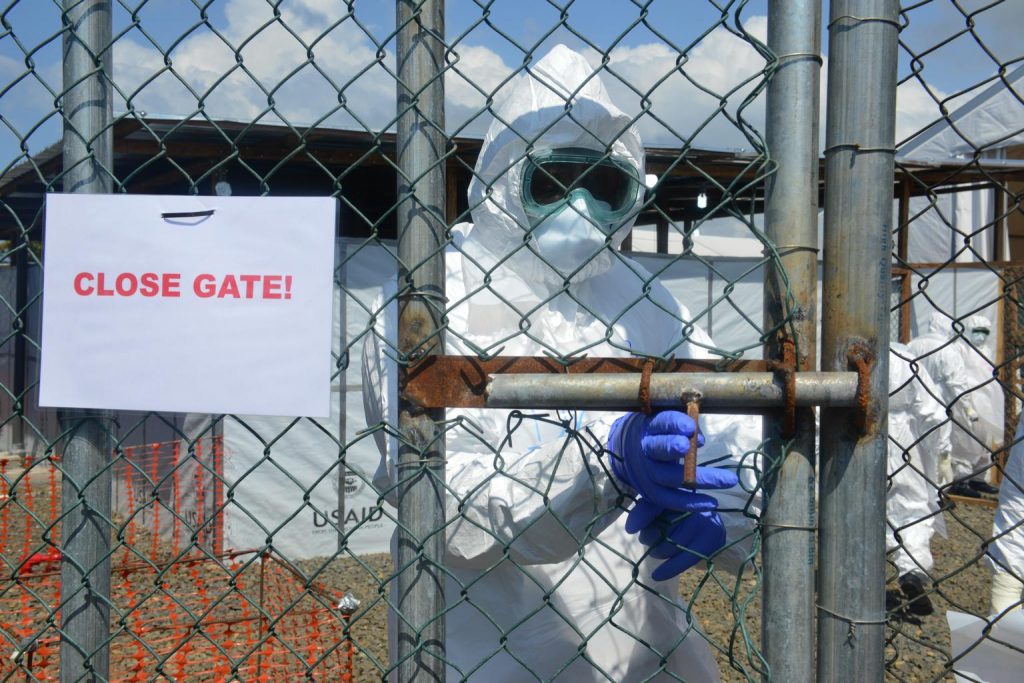Nicholas B. King revient sur la dialectique de la confiance et de la paranoïa lors des épidémies d'Ebola de 1995 et 2014.
Examens des preuves
Ébola, 1995/2014

UNICEF/UNI174680/Nesbitt
Le 13 novembre 2014, un agent de santé portant un équipement de protection individuelle (EPI) ferme une porte menant à la sortie de la zone verte (sûre) d'une unité de traitement Ebola (ETU) nouvellement construite à Monrovia, la capitale. Il fait partie d'un groupe d'agents de santé qui se préparent à entrer dans la zone rouge (à haut risque) de l'unité pour soigner des patients. Tout le personnel travaillant directement avec des patients Ebola en quarantaine doit enfiler l'équipement de protection (une combinaison de combinaisons, de gants et de bottes robustes, de lunettes et de tabliers) avant d'entrer dans la zone à haut risque, afin d'éviter toute exposition au virus. L'unité de traitement, située dans le quartier de Congotown à Monrovia, près du complexe du ministère de la Défense, est composée d'agents de santé du Libéria, de Cuba et des pays de l'Union africaine. L'UNICEF fournit de l'eau pour répondre aux besoins de boisson, de lavage, de bain et de désinfection des patients de l'établissement de santé, qui dispose de deux stations de désinfection au chlore. Au moins 150 litres d’eau sont nécessaires pour soigner pleinement chaque patient atteint d’Ebola, soit 10 fois la quantité qu’un Libérien utilise normalement. L'ETU est l'une des deux unités construites en octobre 2014 avec le soutien de l'UNICEF, de l'USAID, du Programme alimentaire mondial (PAM), de l'Organisation mondiale de la santé (OMS) et du gouvernement libérien, pour aider à traiter le trop grand nombre de patients atteints d'Ebola dans d'autres établissements de santé. Les unités ont chacune une capacité de 100 lits. En novembre 2014, le Libéria reste l'un des trois pays d'Afrique de l'Ouest connaissant une transmission généralisée et intense de la maladie à virus Ebola (MVE). L'UNICEF continue de soutenir les efforts de mobilisation sociale visant à sensibiliser l'opinion à la maladie, à ses symptômes et aux moyens de prévenir sa propagation – autant d'éléments essentiels pour enrayer cette épidémie sans précédent. L'UNICEF reste à l'avant-garde des efforts visant à répondre à l'épidémie et à l'endiguer. Depuis le début de l'épidémie, l'UNICEF a apporté 967 tonnes d'aide d'urgence, notamment des équipements de protection essentiels, des tentes, des kits antidiarrhéiques, des kits sanitaires d'urgence et des produits d'assainissement tels que du chlore.
Contenu associé
Infographie
Considérations clés : Engagement des enfants dans le contexte des épidémies en Afrique orientale et australe
Cette infographie résume les enseignements d’une récente note d’information sur les considérations clés sur l’engagement des enfants dans le contexte des épidémies en Afrique orientale et australe. Cette note explore pourquoi, quand et comment impliquer les enfants dans la prévention, la réponse et…
Hub d’Afrique centrale et orientale
SSHAP
2024
Infographie
Considérations clés pour répondre aux inondations au Soudan du Sud à travers le lien humanitaire-paix-développement
Cette infographie résume les enseignements d'un récent rapport sur les considérations clés sur la réponse aux inondations au Soudan du Sud à travers le prisme du Nexus Humanitaire-Paix-Développement (HDP). La note décrit les impacts multidimensionnels des inondations sur la paix, la santé, les moyens de subsistance et la gouvernance et…
Hub d’Afrique centrale et orientale
SSHAP
2024
Compte rendu
Considérations clés : Engagement des enfants dans le contexte des épidémies en Afrique orientale et australe
Des stratégies efficaces de participation des enfants sont essentielles pour optimiser la réponse aux épidémies et minimiser leur impact tout en garantissant la protection, le bien-être et la résilience des enfants. Lorsque les enfants comprennent les épidémies, ils sont mieux à même d’y faire face, d’y contribuer et de s’en remettre. Cela favorise…
Hub d’Afrique centrale et orientale
SSHAP
2024
Compte rendu
Considérations clés pour répondre aux inondations au Soudan du Sud à travers le lien humanitaire-paix-développement
Comme de nombreux autres pays africains, la République du Soudan du Sud est de plus en plus confrontée à des inondations dévastatrices liées au changement climatique.1,2 Le dipôle de l’océan Indien (IOD) et El Niño régulent le climat de l’Afrique de l’Est équatoriale. En 2019, un dipôle…
Hub d’Afrique centrale et orientale
SSHAP
2024


